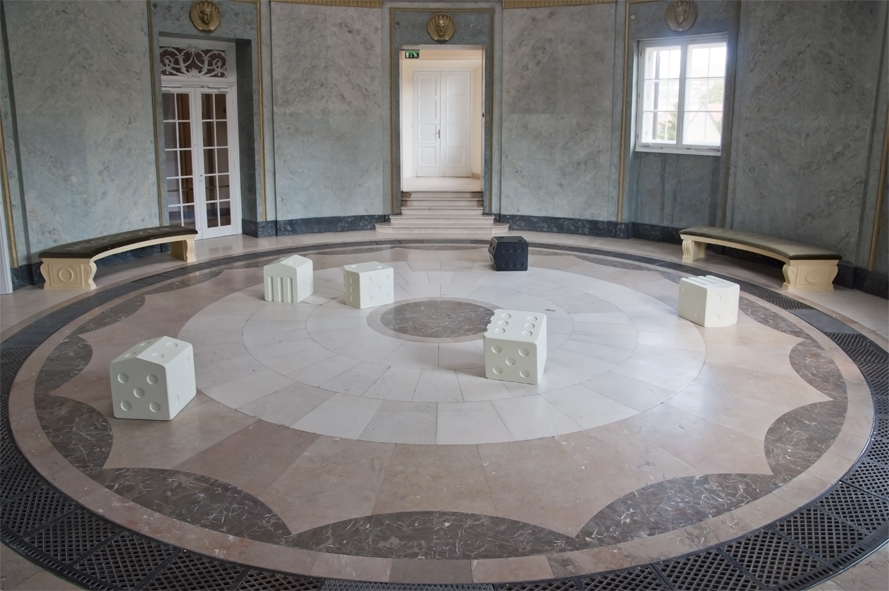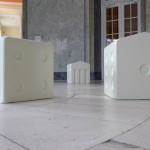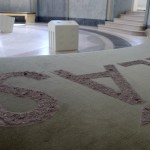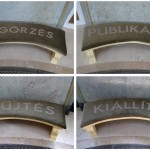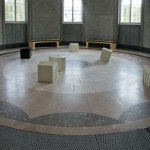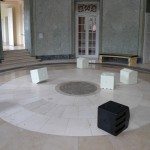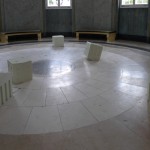Relatív szerencse / Relative Luck
2012
térinstalláció, Déri Múzeum, Debrecen
installation, Déri Museum, Debrecen
A debreceni Déri Múzeum kupolatermének kör alakú termében elszórt rendezetlenségben hat darab méretes dobókockára emlékeztető kubust helyeztem el. A kockák két oldalukon módosított, egyébként pöttyökkel ellátott, egyszínű, homogén tárgyak. A rendhagyó oldal egy múzeum sematizált piktogramját mutatja, emlékeztetve az információs közúti táblákról jól ismert jelre. Az ily módon létrejövő tárgy ötvözete egy méretes dobókockának és egy makett méretű, emblematikus múzeumépületnek. A kockák játékos összevisszaságban találhatóak a padlón, mintha épp most gurultak volna ki egy képzeletbeli játékos kezéből. A terem szélén elhelyezett, az épülethez tartozó padok nem látható játékosok jelenlétét feltételezik. A burkolat mintázata pedig ismeretlen szabályokat sejtető játékmezőként értelmezhető az új kontextusban. A körben található négy pad bársonyos tapintású plüss huzatára hamuval írtam fel egy-egy szót. A szavak a múzeumi törvényben rögzített alapfunkciókat formázzák, úgymint: gyűjtés; megőrzés; kiállítás; publikálás. Elképzelésem szerint a munka nem csak formai szempontból igazodik az épületrész fizikai paraméterihez, hanem helyzetspecifikusan, a közelmúltban végbement felújítási munkák okozta anomáliára is reflektálni kíván. Minden dobókocka egyben egy múzeumépületet is szimbolizál, melynek sorsa a kiszámíthatatlan, hazardírozós játék szeszélyei szerint alakul.
Six pieces of large cubes reminiscent of dice are placed in disorder in the round Dome Hall of the Déri Museum. The cubes are homogeneous, single coloured but dotted objects modified on two of their sides. Dots are not painted but appear deepened on the sides. (The number of cubes: 5 pieces of white and 1 piece of black, 45x45x52 cm each.) The irregular side of the cube depicts the schematized pictogram of the museum with four columns; its roof design with an angle of 15 degrees reminds us of the well-known sign of traffic boards. Thus, the object being created is a combination of a large-scale die and a small-scale building of a museum with classicist features. The cubes are found on the floor in playful disorder, as if they have just rolled out from the hands of an imaginary gambler. There are benches belonging to the building at the edge of the room which indicate the presence of invisible gamblers. According to the new context, the pattern of the covering of the suitcases might be interpreted as a game field suggesting unknown rules. Each cube has a nonfigurative concept written in ash on the floor. The curving text shows the presumptive ground track of the cube. The words of the text form the basic functions of the museums by law, such as collection, prevention, exhibition, publication, restoration, and registration. In my opinion, this piece of work becomes specialized to the physical space of this part of the building not only in a formal aspect but also in a circumstantial aspect, since it tries to reflect on the anomaly which was caused by the recent renovation works of the building, that became a general phenomenon over the past few years in Hungary.

